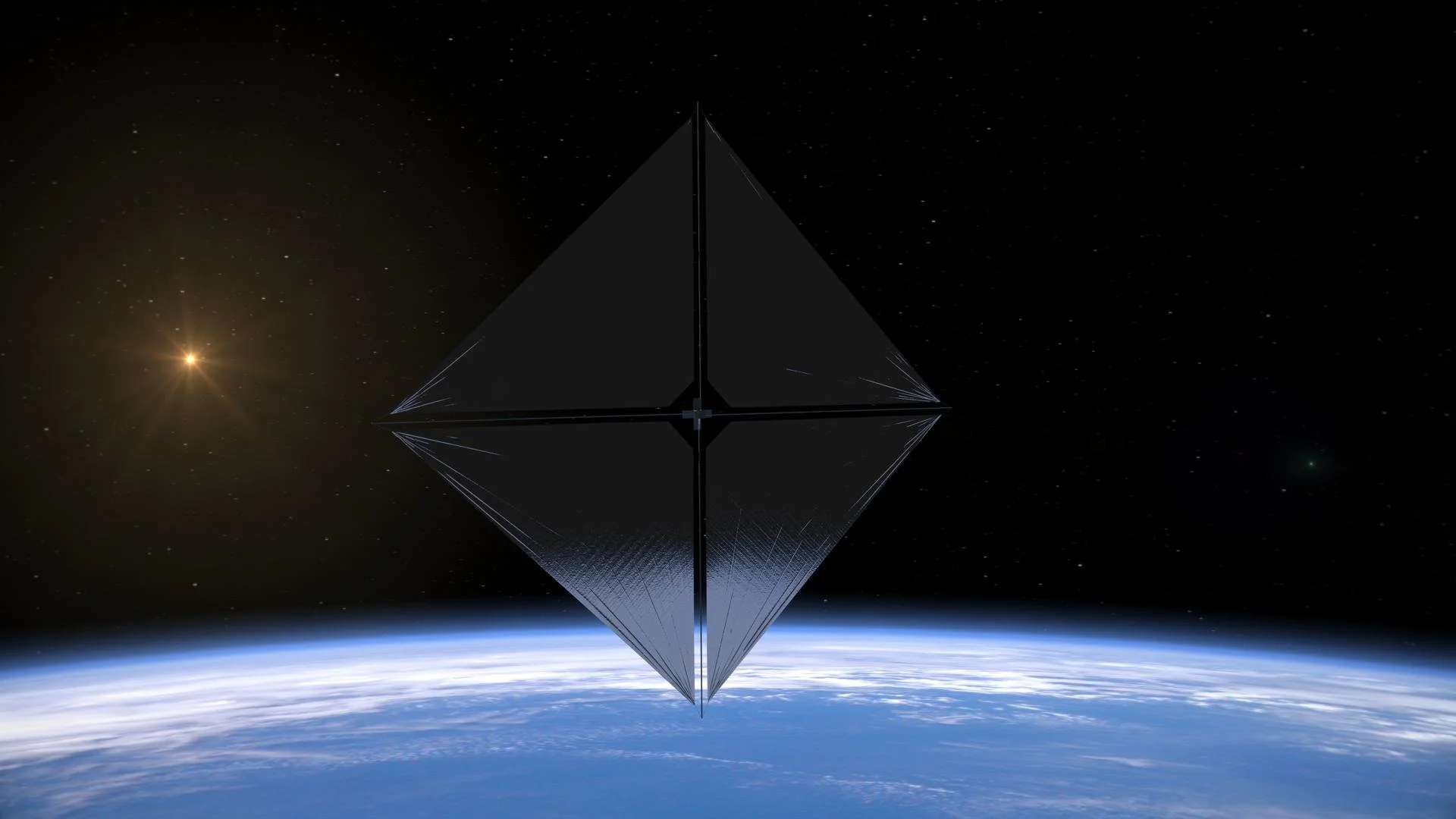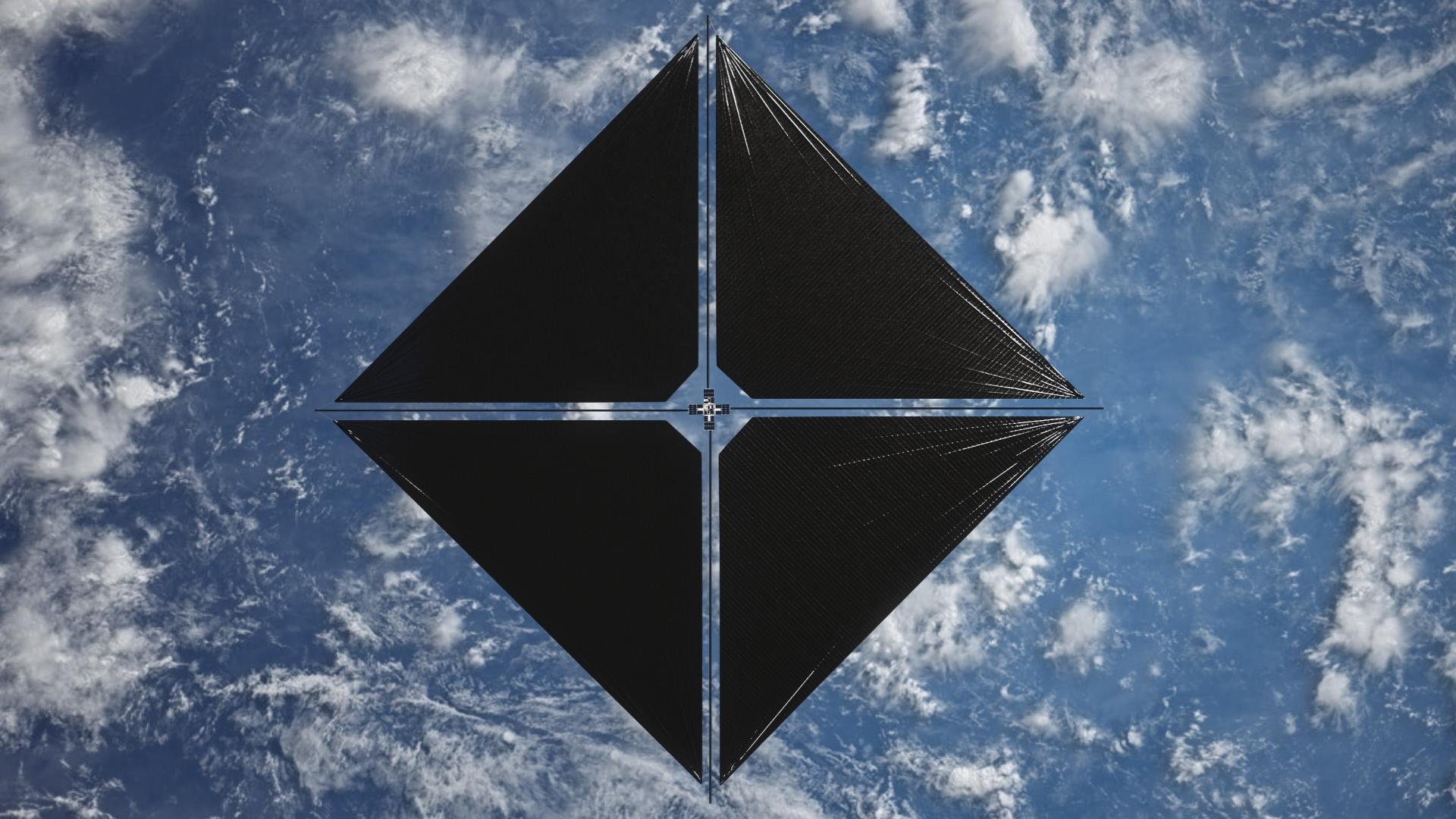Future of Deep Space Travel
Heliogyro Solar Sailing and the Promise of Propellant-Free Propulsion
At Stella Nova, we believe that the future of space exploration demands innovation that is not only bold but also elegantly efficient. Among the most promising advances in spacecraft propulsion is solar sailing—a technology that turns sunlight into momentum, offering a truly fuel-free path through the cosmos.
One of the most novel and scalable designs in this domain is the Heliogyro Solar Sail, a concept we developed and prototyped while working at NASA Langley Research Center. This blog offers a behind-the-scenes look at how that concept evolved, and why it’s poised to revolutionize interplanetary travel.
What is Solar Sailing?
Solar sailing is a method of propulsion that uses the pressure of photons—particles of light emitted from the sun—to push a spacecraft forward. While the force from each photon is tiny, it is constant and free — meaning that over time, and with a large enough reflective surface (the "sail"), a spacecraft can build up significant speed without burning any fuel.
Think of it like a sailboat—except the wind is sunlight, and the destination could be Mars, an asteroid, or deep interstellar space.
What Makes Solar Sailing So Special ?
Solar sailing isn’t just a different way of propelling a spacecraft—it’s a radically elegant approach that opens up possibilities traditional rockets can’t. To understand its value, let’s explore the key advantages with a few everyday analogies that bring this concept down to Earth.
1. No Propellant Required
Analogy: Imagine a car that never needs refuelling—because it runs on sunlight.
Traditional spacecraft are like cars with a limited gas tank. Every maneuver burns fuel, and once that tank is empty, the journey ends. With solar sailing, the spacecraft is pushed forward by the momentum of sunlight—specifically, by solar photons. These are tiny packets of energy that strike the sail and generate thrust.
Since sunlight is always available in space (at least within the inner solar system), the sail doesn’t need fuel. This means:
Longer missions
Lower launch mass
Fewer moving parts
It’s the closest thing we have to a perpetual motion spacecraft.
2. Continuous Acceleration
Analogy: Like pushing a child on a swing—you give a tiny nudge every few seconds, and over time, they’re flying high.
Each photon provides only a small push, but solar sails are designed to capture those tiny nudges continuously. While rockets deliver big bursts of speed and then coast, solar sails keep accelerating for days, weeks, or even years.
This technology could drastically reduce the size and cost of future accelerators, potentially opening doors to new physics research and real-world applications in medicine, energy, and materials science.
3. Scalable and Lightweight
Analogy: Think of a camping tent that folds into a small pouch but can cover a large area when deployed.
Solar sails are made from ultra-thin, lightweight materials—often thinner than a human hair—and they can be folded into a compact volume for launch. Once in space, they unfurl to hundreds or even thousands of square meters.
This is especially powerful for small satellites like CubeSats, which are extremely limited in both volume and mass. A tiny spacecraft can carry a huge sail—and suddenly, it has the means to fly across the solar system.
4. Multi-Mission Flexibility
Analogy: Like a sailing ship that can change direction at sea, explore new islands, and come back—without ever docking for fuel.
Because there’s no fuel to burn, solar sails can be reused and redirected multiple times. This opens the door for missions that are:
Adaptive
Long-lived
Capable of performing sequential objectives
A single spacecraft could visit an asteroid, change its trajectory, and then station-keep at a strategic solar orbit—all with zero refuelling or servicing.
5. Elegant Navigation Through Light
Analogy: Like adjusting the angle of your umbrella in the wind—you can feel how the direction changes depending on the tilt.
In solar sailing, direction is controlled by how the sail is oriented to the sun. Tilt the sail one way, and the photon pressure pushes you in that direction. Tilt it another way, and you drift elsewhere.
In the Heliogyro design we developed at NASA, the sail consists of long spinning blades that can be extended or retracted individually. By shifting the spacecraft’s center of mass and pressure, it can turn and steer itself—all without thrusters, vanes, or chemical propellant.
What is Heliogyro Orbital Platform in Space?
At NASA, we took this concept further by developing the Heliogyro Orbital Platform in Space (HOPS2B)—a demonstration of how to package solar sailing into a compact, modular spacecraft format using CubeSats.
The HOPS2B concept featured:
A 2-blade solar sail system, each blade made from 2-micrometer-thick polymer film and measuring up to 2.4 kilometers when fully deployed.
A 6U CubeSat configuration (approx. 10 x 20 x 30 cm), integrating everything from sail reels to attitude control, sensors, and communication.
Retractable solar blades that could be extended or retracted to change the Center of Pressure (CP) relative to the Center of Mass (CM) — allowing us to steer the spacecraft by shifting this balance point while spinning.
This unique ability to steer via blade extension and retraction, without thrusters or vanes, meant that the same system used for deployment could serve as navigation and propulsion — a radical simplification and efficiency gain for future missions.
We envisioned missions such as:
Heliophysics Missions
Interplanetary travel
Asteroid mapping and redirection
Station-keeping at Lagrange point
De-orbiting defunct satellites
Near-Earth object monitoring
Dr. Wiwattananon Role at NASA Langley Research Center
During Dr. Wiwattananon´s time at NASA Langley, she had the privilege of securing research funding to explore novel in-space propulsion concepts. With that, she built a small, interdisciplinary team focused on developing the Heliogyro Solar Sail.
Here’s a snapshot of what Dr. Wiwattananon worked on:
Trade studies of miniature motors suitable for CubeSat integration. We reviewed over 130 commercially available piezoelectric and electric motors to find solutions that could deliver the required torque within tight mass and volume constraints.
Breadboard prototyping and physical testing of membrane deployment, focusing on tensioning under centrifugal forces.
Designing and modeling steering concepts based on the physics of CM/CP offset through blade dynamics—this was key to enabling precise maneuvers without using any fuel.
Creating scalable configurations that optimized the balance between sail area, payload space, and achievable acceleration—a modular systems engineering approach inspired by product design thinking.
These projects were deeply collaborative, engaging with engineers, scientists, and mission planners to push the boundaries of what small spacecraft could do.
What This Means for Stella Nova’s Clients
At Stella Nova, our mission is to bring the elegance of advanced engineering into practical, future-forward solutions for our clients—whether they're working in space, medical tech, AI, or frontier hardware. The work we did on heliogyro-configured solar sails at NASA is more than a piece of our history—it's a blueprint for how we think and innovate.
So, what does solar sailing—and the Heliogyro concept—mean for you?
1. Designing for Sustainability and Endurance
Just like solar sails offer a way to travel without fuel, Stella Nova helps clients design products and systems that minimize reliance on consumables, reduce maintenance needs, and maximize longevity. Whether it’s a self-sustaining satellite, a low-power sensor network, or an autonomous medical device, the lesson is the same:
Simplicity scales. Efficiency extends capability.
2. Modularity + Scalability = Flexibility
The heliogyro sail system was built using modular, scalable elements—reels, blades, and motors—that could be adapted to different missions and spacecraft sizes. We take the same approach in our consulting work, helping clients architect systems that are easy to scale, pivot, or reconfigure.
Whether you’re launching a product line or preparing for growth, we know how to engineer for evolution.
3. Vision-Driven Innovation
Solar sailing is a long-game technology. It requires vision. At Stella Nova, we collaborate with clients who are ready to invest in what’s next, not just what’s now. We help you push beyond quick fixes and toward strategic, high-leverage engineering solutions—ones that will still make sense in five or ten years.
If you’re exploring uncharted territory, we bring the mindset, structure, and cross-disciplinary thinking needed to turn bold concepts into testable, fundable, buildable reality.
4. Precision Without Overengineering
Our Heliogyro project showed how a spacecraft could steer itself using nothing but its own mass distribution and the pressure of light. That kind of minimalist control—where elegance replaces excess—is exactly the kind of thinking we apply to product development today.
For clients, that means:
Smarter mechanisms
Lower power budgets
Simpler control architectures
Reduced cost and risk
5. A Propulsion System for Ideas
Solar sailing isn’t just a propulsion technology—it’s a metaphor for how Stella Nova works. We help you orient your sails in the right direction, harness the forces already present (in your team, technology, or market), and set a course for momentum that builds over time.
Whether you’re a startup founder, an R&D leader, or a systems architect, our role is to be your engineering co-pilot, helping you navigate uncertainty and accelerate toward your long-term mission—with grace, ingenuity, and confidence.
Ready to work with a team pushing the boundaries of your product innovations?
Let's discuss how we can bring this same innovative approach to your next project.



